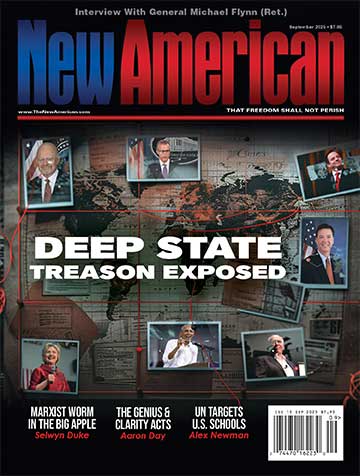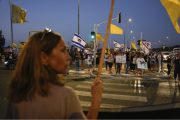
A U.S. nuclear bomb planned for development could pulverize central Moscow and kill over 300,000 of its 13 million inhabitants, Newsweek magazine reported on November 3, citing a simulation set up via the online tool Nukemap.
The Pentagon declared late last month that it is trying to manufacture a new variant of the B61 nuclear gravity bomb — the B61-13 — pending the approval of Congress. Notably, this bomb would have an estimated 360-kiloton yield, which is 24 times more powerful than the one dropped on Hiroshima during World War II.
If detonated over Moscow, the bomb would kill an estimated 311,480 people and wound up to 868,860, Newsweek stated. If dropped on St. Petersburg, Russia’s second-largest city, the bomb could kill around 360,150, the publication continued.
Newsweek reported that anything within a half-mile radius from the bomb’s detonation site would be vaporized by a massive fireball. Those within a mile of the blast would likely be killed immediately, and buildings would be devastated. Anyone within two miles of the site would be dead within a month because of high levels of radiation exposure, the magazine penned. An additional 15 percent of survivors would later die of cancer, and many would suffer life-altering burns.
The plan to design a new bomb was revealed amid Russia and NATO’s faceoff over Ukraine, as pundits, politicians, and the media have evaluated the risks of the conflict intensifying into a nuclear war.
Russia has lambasted America for “nuclear brinkmanship” and alleged it was clandestinely breaching arms-control agreements.
On November 2, Russia formally revoked its ratification of the 1996 Comprehensive Nuclear-Test-Ban Treaty (CTBT). Russian President Vladimir Putin said the non-proliferation treaty is pointless, as the U.S. never ratified it.
“Among the states that have not ratified the treaty, the most destructive position is that of the US, which has for many years declared that there would be no support for ratifying the treaty in Congress,” the Kremlin said in a statement.
The Russian side pointed out that the U.S. Congress has avoided ratifying the 1996 agreement for over 25 years “under far-fetched pretexts.”
“This couldn’t go on forever,” the Russian Foreign Ministry said. “In conditions when the United States is pursuing a deeply hostile course towards our country, maintaining the previous imbalance in approaches to the CTBT that has developed between Moscow and Washington turned out to be no longer possible.”
Putin highlighted that Russia would not carry out nuclear tests unless the U.S. does so first.
On November 3, the Russian Foreign Ministry warned the U.S. not to restart full-scale nuclear tests, since Putin withdrew Moscow’s ratification of the CTBT to reportedly restore parity between Russia and the U.S.
“The United States must understand that conducting full-scale tests, for which the infrastructure in Nevada is reportedly prepared, will force us to respond in kind,” the ministry said in a statement.
Last month, the U.S. Department of Energy’s National Nuclear Security Administration (NNSA) conducted an underground detonation at a site northwest of Las Vegas with the goal of “improving the detection of underground nuclear explosive tests.” The explosion entailed “chemical high-explosives and radiotracers,” the NNSA disclosed.
The U.S. has not conducted a live nuclear test since 1992. Russia has openly said it will not resume testing first, but will respond if Washington forces its hand.
Nonetheless, the Pentagon has recently unveiled plans for developing a high-yield version of the B61 gravity bomb, while a congressional advisory body has called for a huge expansion of the U.S. nuclear arsenal, regardless of the cost.
Earlier this week, the U.S. Air Force blew up an unarmed Minuteman III intercontinental ballistic missile (ICBM) during a test, after it experienced an unspecified “anomaly” that would have to be looked into. This was the second such test since early September.
The U.S. is hoping to replace its aging missiles with a new design, which is scheduled to be ready in the 2030s.
Meanwhile, Nikolay Patrushev, secretary of Russia’s Security Council, has declared that his country has obtained an advantage over its rivals in the field of nuclear weapons.
Patrushev had warned earlier this year that although Moscow had never used its military advantage to alarm other countries, it could eradicate any foe if its very existence was threatened.
In March, he maintained that although Russia has state-of-the-art and unique weapons that it could use to annihilate any enemy that jeopardized its existence, it remains “patient and does not intimidate anyone with its military advantage.” At that time, Patrushev also denied claims that Russia would not be able to retaliate if the U.S. launched a preemptive strike. “It is short-sighted stupidity, and extremely dangerous at that,” he highlighted.
Speaking at the ‘Znanie’ (Knowledge) education marathon in Moscow recently, Patrushev divulged that “for the first time in the history of the existence of nuclear missile weapons, our country is ahead of its competitors in this domain.”
He elaborated that Russia currently has “unique strategic weapons, including hypersonic ones,” in its arsenal. These strategic systems “will guarantee Russia’s security for many decades,” Patrushev posited.
Moscow possesses several types of hypersonic projectiles, such as the Kinzhal air-launched missile, which entered service in 2017. Based on Putin’s revelations, unlike an ordinary ballistic missile, Kinzhal’s high maneuverability and speed permit it to penetrate any existing air defense system. In 2018, the Russian military also procured the Bulava submarine-launched ballistic missile, which has been characterized as the future cornerstone of the country’s nuclear triad.
According to the Stockholm International Peace Research Institute (SIPRI), as of 2023, Russia has the largest nuclear arsenal in the world, with a total stockpile of 5,889 warheads. Its closest rival, the U.S., has a total of 5,224 warheads.
Patrushev’s comments come as bilateral ties between Russia and Washington have fallen to historic lows, mainly owing to the fallout from the Russo-Ukrainian conflict. Shortly after tensions erupted in February 2022, Putin ordered the country’s nuclear forces to be put on “special alert.” Nevertheless, U.S. officials have insisted that they have not come across any noticeable changes in Moscow’s nuclear stance.




